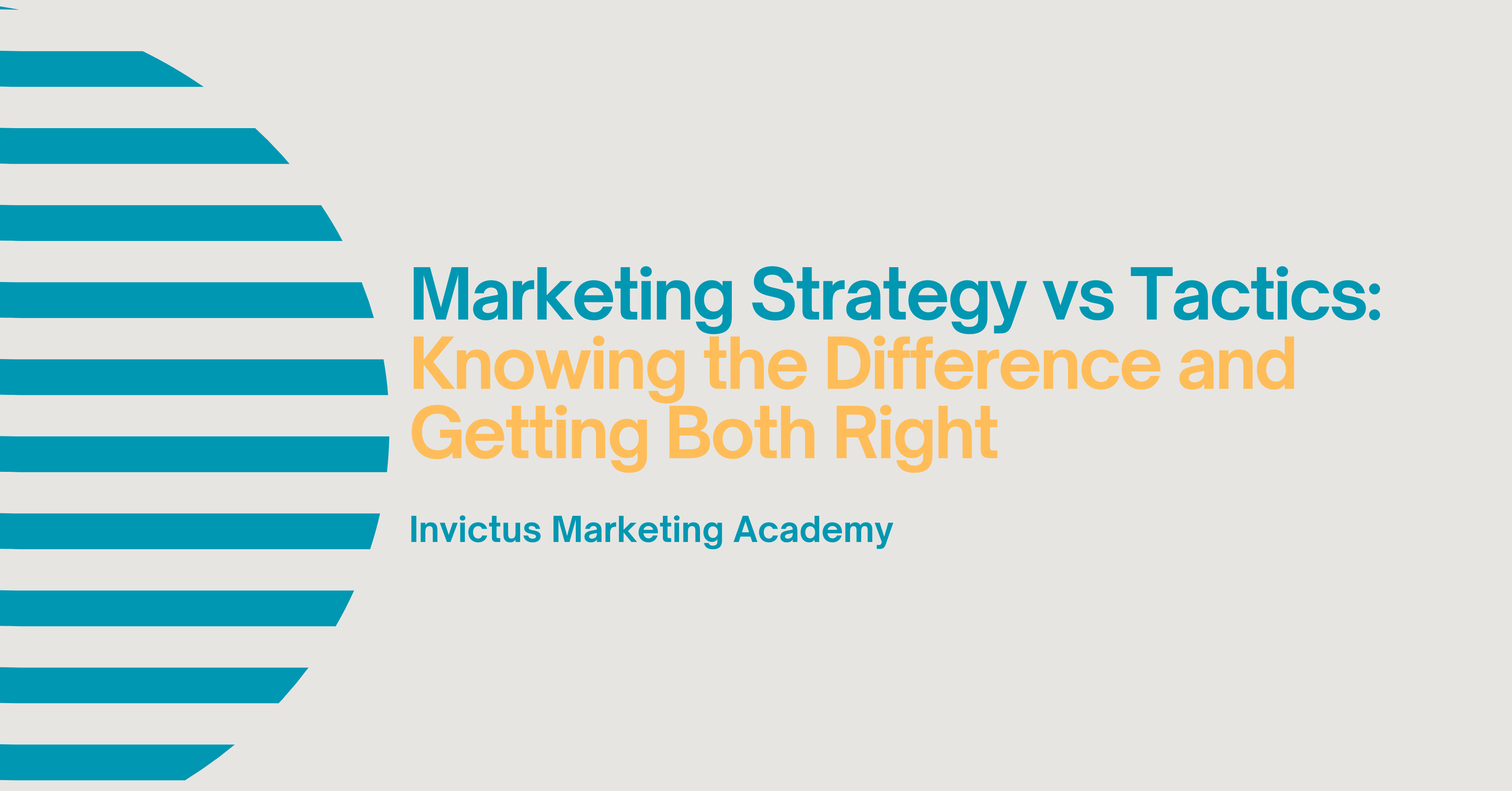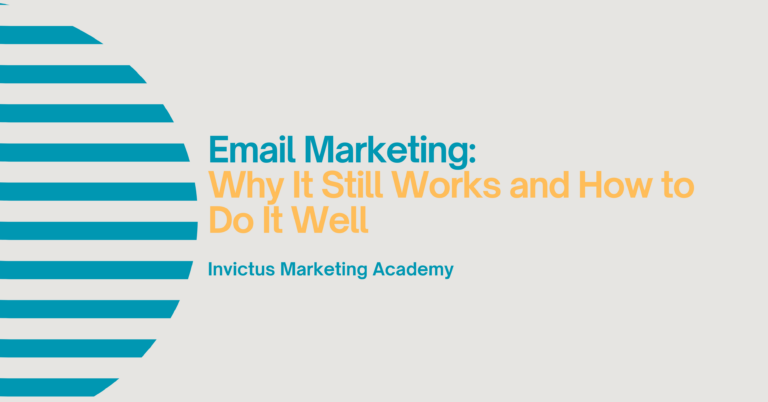Marketing Strategy vs Tactics: Knowing the Difference and Getting Both Right
You’ve probably heard people in meetings say things like “We need a marketing strategy” — only for the conversation to jump straight into Instagram hashtags, newsletter send dates, or ideas for the next blog post. It’s a common mix-up in marketing: strategy and tactics are not the same, yet they’re often treated as interchangeable.
In reality, understanding the difference — and how they work together — is what separates scattergun activity from focused, effective marketing. It’s the difference between a brand that feels intentional and one that’s constantly chasing the latest trends with no clear direction.
In this article, we’ll clarify what a marketing strategy really is, how it differs from tactics, and how the two combine to create marketing that doesn’t just look good — but delivers results.
What Is Marketing Strategy?
Your marketing strategy is your overarching plan of action — it sets the course for all of your communications and campaigns. It defines who your ideal customers are, what value you offer them, what you want to achieve in the market, and how you’ll position your business against the competition.
Strategy is rooted in long-term thinking. It’s not reactive. It’s based on insight from data, research, and experience — and it informs every major decision you make in marketing. It considers not only what your brand is doing, but why, for whom, and to what end.
A good strategy answers questions like:
- What are our key business goals?
- Who are we trying to influence, persuade, or serve?
- What market problem are we solving?
- What competitive advantages do we offer?
- How will we position ourselves to stand out?
It sets the guardrails that keep your messaging, campaigns, and marketing activity consistent, purposeful, and aligned with your long-term brand direction.
Without strategy, you might be active — but you’re unlikely to be effective.
What Are Marketing Tactics?
Tactics, by contrast, are the specific tools, techniques, and actions you use to implement your strategy.
They’re operational. They exist at campaign level. They answer the “how” — how you’ll reach people, how you’ll get them to act, and how you’ll achieve your short-term marketing goals.
Examples of tactics include:
- Running a Facebook ad campaign targeting a specific demographic
- Publishing a blog series to improve SEO visibility
- Creating a lead magnet to grow your email list
- Hosting a product launch event or webinar
- Offering a limited-time referral discount
Tactics are not inherently strategic on their own. Their value comes from how well they support your strategy. When tactics are selected without clear direction, they can lead to wasted budget, inconsistent messaging, and marketing that feels disjointed or unfocused.
The Relationship Between Strategy and Tactics
Strategy and tactics are two parts of the same system — they’re sequential, not interchangeable.
A helpful hierarchy looks like this:
- Strategy – Sets the long-term vision, target audience, and position in the market
- Tactics – Details the short-term actions that bring the strategy to life
- Execution – Organises the implementation of those tactics: timelines, roles, budgets
- Measurement – Evaluates effectiveness and informs the next cycle of planning
When you get the strategy right, tactics become clearer and more coherent. Each tactical choice supports a broader direction. The social post isn’t just filler — it’s reinforcing your brand values. The webinar isn’t just content — it’s a way to generate qualified leads within your chosen segment.
Successful brands revisit this hierarchy constantly, ensuring that every campaign, every platform, and every message links back to the core strategy.
How to Develop a Marketing Strategy
Crafting an effective marketing strategy requires research, reflection, and clear business alignment. It’s not a “one-hour brainstorm”. It’s a process that uncovers the most valuable opportunities and gives your team the confidence to pursue them with focus.
1. Understand the Market Landscape
Before you plan any campaigns, you need to understand the environment you’re operating in.
This includes:
- Emerging trends in customer behaviour
- Competitor activity and market positioning
- Political, economic, social, and technological forces (use PESTEL analysis)
- Strengths and weaknesses in your own business (use SWOT analysis)
Strategic thinking begins with perspective — understanding what’s happening outside your business before making decisions inside it.
2. Define Your Audience and Segments
Who are your customers? What motivates them? What barriers stand between them and your product or service?
Use segmentation techniques to group customers by:
- Demographics
- Behaviour
- Psychographics
- Needs and pain points
This allows for targeted strategies that reflect the real lives, language, and priorities of your ideal customers — not generic assumptions.
3. Clarify Your Brand Positioning
Positioning is how you want to be perceived — in relation to your competitors, and in the minds of your audience.
You might position your brand as:
- The affordable alternative
- The premium, expert choice
- The fun and approachable option
- The sustainable innovator
- The customer-first problem solver
Your positioning must be believable, relevant to your audience, and differentiated enough to stand out. It will shape your tone of voice, content style, and key messages across all channels.
4. Set Strategic Objectives
Your strategy needs to align with the business goals — and set measurable milestones for marketing success.
Examples might include:
- Increase brand awareness in a new region by 40% within six months
- Generate 500 qualified leads from an upcoming campaign
- Improve customer retention rate by 20% through better onboarding
These objectives will later inform which tactics and platforms are chosen — but they must be defined first.
Tactical Planning: Making Strategy Work
Once your strategy is set, tactical planning brings it to life. This is where creativity meets structure — deciding what actions will be most effective based on your objectives, audience, and resources.
Tactical plans should answer:
- Which channels are best suited to this audience?
- What type of content will resonate?
- How often should we publish or promote?
- What’s our budget, and how will it be allocated?
- Who will deliver each activity and when?
Importantly, tactics should not be chosen simply because they’re trendy or comfortable. TikTok might be booming, but if your audience is on LinkedIn, your strategy should reflect that. Similarly, tactics must be reviewed regularly — what worked 12 months ago may not work today.
A Practical Example: A Local Fitness Studio
Imagine you run a boutique fitness studio in Newcastle, specialising in strength and mobility training for beginners and people who feel excluded by mainstream gym culture.
Your strategy might be:
- Positioning: The inclusive, body-positive space for first-time gym-goers
- Target Audience: Adults aged 30–55 who are seeking a welcoming, non-intimidating environment to build strength and confidence
- Brand Message: “Fitness should feel good, not fearful”
- Objectives: Increase class sign-ups by 30% and boost email list growth by 500 contacts in three months
Your tactics could include:
- A series of video testimonials from real members sharing their journeys
- A targeted Facebook and Instagram ad campaign highlighting your friendly ethos
- A downloadable “Beginner’s Guide to Strength Training” lead magnet
- A pop-up event or taster session at a local community space
- An email series introducing your coaches and class options
The strategic direction gives each of these tactics purpose. They’re not just activities — they’re part of a cohesive message and customer journey.
In Summary
The distinction between marketing strategy and tactics is one of the most important — yet often overlooked — fundamentals of effective marketing.
- Strategy is the vision: the “why”, “who”, and “where” that guides your decisions.
- Tactics are the actions: the “what” and “how” that bring that vision to life.
When strategy is clear and grounded in insight, your tactics become sharper and more consistent. And when your tactics are well-executed and measured, they feed useful insight back into your strategy — creating a powerful cycle of improvement.
Mastering the balance between strategy and tactics is what turns marketing from a series of experiments into a structured, scalable, and successful engine for growth.







